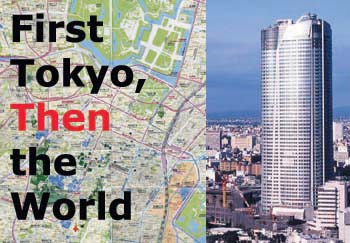
THE WORLD'S TALLEST BUILDING. Structures that lure residents back to the city center. Temples of art and culture. An architectural movement that will first change Tokyo, then the nation, then who knows. This is what the Moris, one of Japan's richest and most influential families, are out to achieve -- and in case you haven't noticed, they are well on their way.
Perhaps no other family in modern Japanese history has had so much influence on Tokyo. The Moris have helped shape the way Tokyo looks -- for better or worse -- for nearly five decades. Their 60 or so office buildings dot Toranomon, Kamiyacho and other sections of western Tokyo, their Ark Hills complex helped lure Western financial firms away from Otemachi when it first opened in 1986, and now their 54-story Roppongi Hills complex -- a massive, ambitious project that will change the face of Tokyo's favorite nightclub district -- is nearing completion. It's scheduled to open in late April 2003.
The Mori family empire started modestly enough. Taikichiro Mori, an economics professor, founded the Mori Building Co. in 1959 with his son Minoru, a University of Tokyo student at the time. Taikichiro had a hunch that there was money to be made in real estate speculation, and, wow, was he right. In 1989, the Mori family, which owns 100 percent of the Mori Building group, had real estate holdings totaling $14.2 billion. By 1990, Forbes ranked Taikichiro as the second wealthiest man in the world, with $15 billion in assets.
But since Taikichiro's death in 1993, the family's empire has shrunk in terms of total assets. Brothers Minoru, 67, and Akira, 65, made the Forbes list of the world's richest men as recently as 1998, when their holdings were estimated at $3.3 billion, less than a quarter of their worth nine years earlier.
Today, only Akira, the chief of Mori Trust, makes the list. His company made aggressive investments this year in Fujita Kanko, Japan's second largest hotel chain, and the Loft variety store chain, and it has also carved out a name for itself in the hot market of real estate investment trusts, or REITS. Akira placed 106th on the 2002 list with a net worth of $3.4 billion. Minoru's name was nowhere to be found. What happened to his fortune? It's still there, but he has taken on substantial debt to fund his vision for Tokyo.
"The problem with Tokyo," says Minoru's son-in-law Hiroo Mori, a managing director and possibly the next in line to run the company, "is that it is not attractive." The Moris are dead-set on making Tokyo attractive in this century -- and they plan to make a lot of money doing it. But Minoru's vision for the city is not without controversy.
The vision
Mori's vision for Tokyo is closely related to Le Corbusier's vision for cities. Le Corbusier, born Charles-Edouard Jeanneret-Gris in La Chaux de Fonds, Switzerland, in 1887, was one of the most influential and controversial architects of the 20th century. Le Corbusier was also an avid writer, sculptor and city planner. His works, the most famous of which include Ronchamp, a church made out of reinforced concrete in France, and the Palace of Assembly in Chandigarh, India, have alternatively inspired and enraged. Critics find his vision authoritarian and overly austere, while proponents, like Mori, who owns more than two hundred of Le Corbusier's paintings and sculptures, find him inspiring.
In fact, when Mori talks about Tokyo, the echoes of Le Corbusier are hard to ignore. Consider this description of Tokyo 10 or 20 years from now by Mori:
"At the least, there should be several areas like (West) Shinjuku. But Shinjuku is mostly made up of business facilities. There will need to be plenty of housing in these areas as well. The skyline should certainly be made up of buildings around 50 stories tall, or 200 meters. Shinjuku's walkways are flat and the towers seem to spring from the earth, but I prefer something more contoured. And along the foundation, I would make space for greenery."
Here's an excerpt from a May 5, 1961, Time cover story on Le Corbusier:
"At the center of (Le Corbusier's) City of Three Million was a group of cross-shaped skyscrapers, 50 to 60 stories high, placed far apart in expanses of greenery, like Ôtowers in a park.' ÔThese skyscrapers,' Le Corbusier airily explained, Ôwill contain the city's brains. Everything is to be concentrated in them: banks, business affairs, the control of industry.' Beyond the central ring was a civic center, and then a series of belts of apartment houses, with a garden for every apartment."
 The boss
The boss
Mori meets me in a private conference room at the top of the Ark Hills complex to discuss his plans for Tokyo. Behind him is a large photograph by Le Corbusier. "It's a city development in India," Mori offers. "He's not the best photographer, but he left behind some great architecture."
Mori is flanked by PR men and women during the interview. They place their own tape recorder in front of me, as if to say, "We'll be checking your translations." And a couple of them take notes throughout. Mori speaks slowly, deliberately. He is immaculately dressed in a dark suit (his father preferred a kimono) and his hair is perfectly coiffured. He has been through this interview a thousand times before and his eyes show amusement as we talk.
Sometimes his answers are so deliberate he almost sounds bored. But at other times, he springs to life, laughs and speaks straight to the question. I say that many people find charm in Tokyo's disorder, its gocha-gocha aspects, but that Mori seems determined to bulldoze those aspects into the past. "The ones who praise that are the Japanologists, aren't they? They come once and find it interesting," he says with a smile, "but they don't come again."
What Tokyo needs, he says later in the interview, is "more Omote Sandos."
Not everybody agrees. Or even if they agree with the vision, they're not sure Mori is the one to execute it.
"I'd love to see more leafy, pleasant Omote Sandos," says Adam Greenfield, lead information architect for Frontage-Razorfish in Tokyo. "But, you know, for the life of me I can't conceive of any way in which Mori's plans might conduce to such a goal.
"How do you get the ease and space and emergent complexity of a broad, leafy, pleasant boulevard out of hypertrophic but otherwise architecturally undistinguished superblocks," asks Greenfield. "The ideas Mori stands for -- and makes concrete in the most literal way, as witness the various 'Hills' developments scattered around Tokyo -- have been rather persuasively discredited almost everywhere else. Here, for whatever reason, they're regarded as advanced thinking."

The zone
The Mori Building people turned an old Nissan showroom on the edge of the Roppongi Hills development into the New Tokyo Life Style Think Zone and opened it in October last year. This was meant to be a taste of things to come. The zone, which is an art space with a cafe and a bookstore, also has its own book. The book tries to explain Mori's vision for cities with catchy phrases, quotes, all presented with a designer's flair. Greenfield for one, was not impressed. "You know, I read New Tokyo Life Style Think Zone -- which is to say, I'm betting that I engaged it more deeply than the majority of folks," he says. "I'm all for utopian fantasies, by the way. I'm simply amused that (this book) seems to recapitulate the dreams of a century of clean-slate reformers, in either ignorance of, or willful inattention to, their notorious failure."
Others are more positive -- if tentatively so. "The thing I'm most worried about is that this beautiful (zone) might be closed or slimmed down for financial reasons that judge this place by its profitableness," writes Tetsuya Ozaki on the RealTokyo Web site (www.realtokyo.co.jp). Ozaki is the editor in chief of the site, which covers Japan's art and design scene in both Japanese and English. "Compared to Mitsui Fudosan or Mitsubishi Estate there is a certain feel of originality to Mori Building," he says in a separate interview. "(But) I think that Roppongi Hills will certainly not make the landscape of this neighborhood look more beautiful."
An architect working in Tokyo says, "I don't know if I like Atago Green Hills," referring to the Mori Building's new complex near Kamiyacho that is home to Moody's Investors Service, among others. "But at least Mori is doing something."
Mori is definitely doing something. His efforts are most noticeable in Minato ward. There the company has recently built Atago Green Hills and Moto-Azabu Hills, a residential complex of three towers. Minato is also home to Ark Hills and the almost complete Roppongi Hills. Hiroo Mori explains Minato's attractions: "It's international; it has 67 embassies, lots of foreigners and plenty of housing. People live and work there."
The son
I meet the son-in-law, Hiroo, in the Ark Hills Club, an exclusive space on the top floor of one of the Ark Hills towers. The waiting area is also a gallery -- Le Corbusier paintings and sketches hang on the walls. To the left, the rooms have an Oriental motif. To the right, the rooms have the plush leather and dark wood of the West. We head to the West to an unoccupied dining room to chat while looking out over the city.
Hiroo is handsome, affable and poised. He has a weak chin and his eyes seem softer than his father-in-law's, but he is still just 41, which means he's at least a decade younger than the average board member.
The Ark Hills project took more than a decade to complete because of trouble buying up all the parcels of land, Hiroo explains. The same has been true with Roppongi Hills, which sprawls over 11 hectares of Roppongi 6-chome. "It took us 14 years to get all the land," Hiroo says. "It took too long."
 The idea for Roppongi Hills was formulated during the bubble years -- when the family's holdings were near $15 billion. But since then the economy has gone into a seemingly permanent funk and the real estate crowd is talking about a 2003 office glut. Could there be worse timing for such a large-scale project?
The idea for Roppongi Hills was formulated during the bubble years -- when the family's holdings were near $15 billion. But since then the economy has gone into a seemingly permanent funk and the real estate crowd is talking about a 2003 office glut. Could there be worse timing for such a large-scale project?
The Moris shake off that kind of thinking. Hiroo explains that the complex will have more than 200 stores and that 300 of the 800 residences already have tenants ready to move in. He says the Virgin Cinema complex will draw crowds, as will the Grand Hyatt Hotel. And that "the companies that grew up in Bit Valley" -- at least the ones that have survived and grown, he qualifies -- will be the occupants of the large office spaces.
Still, protests and petitions have dogged the Mori Building people as they uproot large swathes of land for their projects. Minoru seems like a man who has had his way for a long, long time when he talks of the protesters. "They sign petitions, but when we build it, will they use it? The petitioners end up applying (to use the facilities)," he says.
Other construction companies have enormous sway in Tokyo, but it would be difficult to find a family with as much pull as the Moris. They are out to create more Omote Sandos, they say, but as one skeptic put it, "It sounds like they want Tokyo to be more like Singapore."
The empire
Tucked into a private display room next to Roppongi Hills is a complete model of Minato ward, made to scale and including even the smaller buildings. Each building is removable. One can almost picture Minoru here, looking out over his empire, picking up buildings and placing them here and there to get the look just right. But can Minato ward, and by extension Tokyo, thrive under such an authoritarian vision?
"No," says Greenfield. "If you want a livable city, if you want to snare some of that ever-elusive 'quality of life,' create the conditions that conduce to it at the micro level." In other words, "tweak zoning regulations, adjust the housing code, specify maximum population densities and minimum amounts of off-street parking."
The Moris don't seem to play on the micro level. What's next after Roppongi Hills, I ask Hiroo. "You should check out Shanghai," he beams. There, the Mori Building folks are planning the world's first 500-meter skyscraper, the Shanghai World Financial Center. Le Corbusier would be proud. @
|



 The boss
The boss
 The idea for Roppongi Hills was formulated during the bubble years -- when the family's holdings were near $15 billion. But since then the economy has gone into a seemingly permanent funk and the real estate crowd is talking about a 2003 office glut. Could there be worse timing for such a large-scale project?
The idea for Roppongi Hills was formulated during the bubble years -- when the family's holdings were near $15 billion. But since then the economy has gone into a seemingly permanent funk and the real estate crowd is talking about a 2003 office glut. Could there be worse timing for such a large-scale project? 


